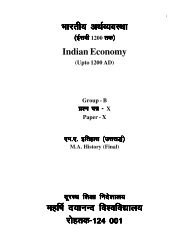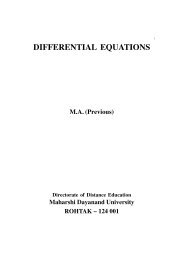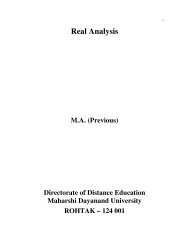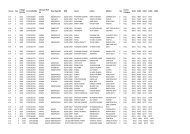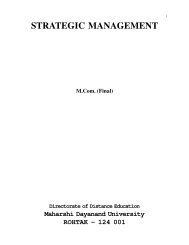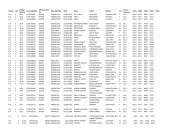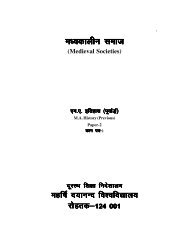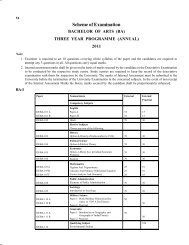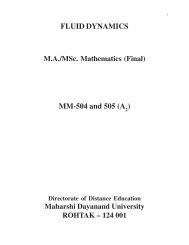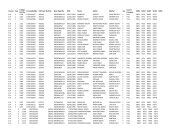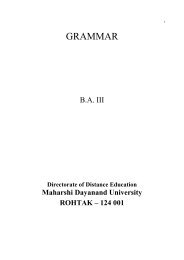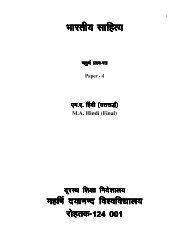Advanced Abstract Algebra - Maharshi Dayanand University, Rohtak
Advanced Abstract Algebra - Maharshi Dayanand University, Rohtak
Advanced Abstract Algebra - Maharshi Dayanand University, Rohtak
Create successful ePaper yourself
Turn your PDF publications into a flip-book with our unique Google optimized e-Paper software.
UNIT-I<br />
13<br />
Corollary 4: (Feremat's Little Theorem):<br />
For every integer a and every Prime p, a p ≡ a (mod p).<br />
Proof:<br />
By division algorithm, a = pm + r, 0 ≤ r < p. Hence<br />
a ≡ r (mod p). The result will be proved if we prove r p r (mod p). If r = 0, the result is trivial. Hence<br />
which forms a group under multiplication module o p. Therefore by corollary 3,<br />
r p-1 = 1. Thus r p r (mod p).<br />
Normal Subgroups<br />
If G is a group and H is a subgroup of G, it is not always true that aH = Ha,<br />
Definition:<br />
A subgroup H of a group G is called a normal subgroup of G if a H = Ha for every a in G. This is denoted<br />
by H ∆ G.<br />
Warning:<br />
H<br />
G does not indicate ah = ha<br />
H ∆ G means that if<br />
,<br />
then ∃ some h 1<br />
H such that<br />
A subgroup H of G is normal in G if and only if x Hx −1<br />
≤ H ∀ x ∈G.<br />
∀a<br />
∈r<br />
hah<br />
≡<br />
∈ a = G{ ∈H<br />
1h G , G. 1<br />
2a<br />
,,.<br />
∀3 ,................. ∈Hd<br />
Θ.<br />
xHx − p<br />
1<br />
−⊆ 1}<br />
H ∀x ∈G xH ⊆ Hx ∀x ∈Gi and<br />
x − 1<br />
Hx x − 1<br />
H x − 1<br />
−1<br />
c⇔<br />
b ∆Hagb = Hbgh Hc = bHab ⊆gH Hc hence = H Hx bab ⊆g Hc xH=<br />
∀H x ∈b ab Ggc<br />
d i , )<br />
b g<br />
cbgh cb gb gh<br />
Factor = Ha groups bc = Ha(or Hquotient bc = Hagroups):<br />
H b Hc ∀a, b, c ∈G.<br />
Let H∆ g.The set of right (or left) cosets of H in G is itself a group. This group is called the factor group of<br />
G by H (or the quotient group of G by H).<br />
Theorem 2:<br />
Let G be a group and H a normal subgroup of G. The set G H<br />
= { Ha a ∈G} forms a group under the<br />
operation (Ha) (Hb) = Hab.<br />
Proof:<br />
We claim that the operation is well defined. Let Ha = Ha 1<br />
and Hb = Hb 1<br />
.<br />
Then a 1<br />
= h 1<br />
a and b 1<br />
= h 2<br />
b, h 1<br />
, h 2<br />
∈H.<br />
Therefore, Ha 1<br />
b 1<br />
= Hh 1<br />
ah 2<br />
b = Ha h 2<br />
b = aHh 2<br />
b = aHb = Hab<br />
(In proving this we used Ha = H a H and H G).<br />
Further He = H is the identity and Ha -1 is the inverse of Ha, ∀ a<br />
(Ha) (He) = Hae = Ha, and Ha Ha -1 = Ha a -1 = He = H,<br />
G.



